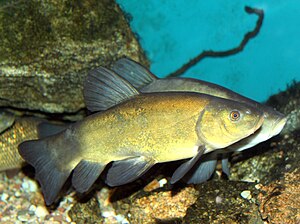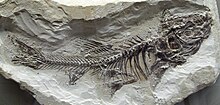bio.wikisort.org - Animal
The tench or doctor fish (Tinca tinca) is a fresh- and brackish-water fish of the order Cypriniformes found throughout Eurasia from Western Europe including the British Isles east into Asia as far as the Ob and Yenisei Rivers.[3] It is also found in Lake Baikal.[citation needed] It normally inhabits slow-moving freshwater habitats, particularly lakes and lowland rivers.[4][5]
| Tench | |
|---|---|
 | |
Conservation status | |
| Scientific classification | |
| Kingdom: | Animalia |
| Phylum: | Chordata |
| Class: | Actinopterygii |
| Order: | Cypriniformes |
| Family: | Cyprinidae |
| Subfamily: | Tincinae |
| Genus: | Tinca Garsault, 1764[2] |
| Species: | T. tinca |
| Binomial name | |
| Tinca tinca (Linnaeus, 1758) | |
| Synonyms | |
| |
Taxonomy
The tench was formerly classified in the subfamily Leuciscinae with other Eurasian minnows, but more recent phylogenetic studies have supported it belonging to its own family Tincidae.[6][7]
Ecology
The tench is most often found in still waters with a clay or muddy substrate and abundant vegetation.[8] This species is rare in clear waters across stony substrate, and is absent altogether from fast-flowing streams. It tolerates water with a low oxygen concentration,[3] being found in waters where even the carp cannot survive.[8]

Tench feed mostly at night with a preference for animals, such as chironomids, on the bottom of eutrophic waters[9] and snails and pea clams in well-vegetated waters.[8][10]
Breeding takes place in shallow water usually among aquatic plants where the sticky green eggs can be deposited.[3] Spawning usually occurs in summer,[4] and as many as 300,000 eggs may be produced.[11] Growth is rapid, and fish may reach a weight of 0.11 kg (0.25 lb) within the first year.
Morphology
Tench have a stocky, carp-like shape and olive-green skin, darker above and almost golden below. The tail fin is square in shape. The other fins are distinctly rounded in shape.[8] The mouth is rather narrow and provided at each corner with a very small barbel.[12] Maximum size is 70 cm, though most specimens are much smaller.[13] A record fish caught in 2001 in England had a weight of 15 lb 3 oz (6.89 kg). The eyes are small and red-orange in colour.[14] Sexual dimorphism is absent or weak, limited to the adult females having a more convex ventral profile when compared with males.[13]
Males may also possess a very thick and flattened outer ray to the ventral fins.[12] Males are generally smaller than females, but can be recognised by having more curved lower fins and noticeable muscles around the base of the fins generally absent in female.[citation needed]
The tench has very small scales, which are deeply embedded in a thick skin, making it as slippery as an eel.[12] Folklore has it that this slime cured any sick fish that rubbed against it, and from this belief arose the name doctor fish.[11]

Golden tench
An artificially bred variety of tench called the golden tench is a popular ornamental fish for ponds. This form varies in colour from pale gold through to dark red, and some fish have black or red spots on the flanks and fins. Though somewhat similar to the goldfish, because these fish have such small scales, their quality is rather different.[11]
Economic significance
Tench are edible, working well in recipes that would otherwise call for carp, but are rarely eaten these days.[8] They are shoaling fish that are popular quarries for coarse angling in rivers, lakes and canals.[3] Tench, particularly golden tench, are also kept as ornamental fish in ponds as they are bottom feeders that help to keep the waterways clean and healthy.[15]
Angling
Large tench may be found in gravel pits or deep, slow-moving waters with a clayey or silty bottom and copious aquatic vegetation. The best methods and bait to catch tench are float fishing and ledgering with a swim feeder using maggots, sweetcorn, pellets, bread, and worms. Fish over 1 kg (2 lb) in weight are very strong fighters when caught on a rod.[16]
References
- Freyhof, J.; Kottelat, M. (2008). "Tinca tinca". IUCN Red List of Threatened Species. 2008: e.T21912A9339248. doi:10.2305/IUCN.UK.2008.RLTS.T21912A9339248.en. Retrieved 19 November 2021.
- Eschmeyer, William N.; Fricke, Ron & van der Laan, Richard (eds.). "Genera in the family Tinca". Catalog of Fishes. California Academy of Sciences. Retrieved 27 November 2020.
- Froese, Rainer; Pauly, Daniel (eds.) (2007). "Tinca tinca" in FishBase. 5 2007 version.
- B. Whitton (1982). Rivers, Lakes and Marshes p 163. Hodder & Staughton, London.
- "Tench". BadAngling. Retrieved 2018-07-06.
- Schönhuth, Susana; Vukić, Jasna; Šanda, Radek; Yang, Lei; Mayden, Richard L. (2018-10-01). "Phylogenetic relationships and classification of the Holarctic family Leuciscidae (Cypriniformes: Cyprinoidei)". Molecular Phylogenetics and Evolution. 127: 781–799. doi:10.1016/j.ympev.2018.06.026. ISSN 1055-7903. PMID 29913311. S2CID 49292104.
- "Order CYPRINIFORMES: Families LEPTOBARBIDAE, XENOCYPRIDIDAE and TINCIDAE". The ETYFish Project. 2018-10-17. Retrieved 2020-11-27.
- A. F. Magri MacMahon (1946). Fishlore, pp 156-158. Pelican Books.
- Perrow, M. R. (1996). "Factors affecting the habitat selection of tench in a shallow eutrophic lake". Journal of Fish Biology. 48 (5): 859–870. doi:10.1111/j.1095-8649.1996.tb01481.x.
- Bronmark, C. (1994). "Effects of Tench and Perch on Interactions in a Freshwater, Benthic Food Chain". Ecology. 75 (6): 1818–1828. doi:10.2307/1939640. JSTOR 1939640.
- A. Lawrence Wells (date unknown). Observer Book of Freshwater Fishes, pp 101-105. Frederick Warne & Co.
- One or more of the preceding sentences incorporates text from a publication now in the public domain: Chisholm, Hugh, ed. (1911). "Tench". Encyclopædia Britannica. Vol. 26 (11th ed.). Cambridge University Press. p. 61.
- G. Sterba (1962). Freshwater Fishes of the World pp 249-250. Vista Books, London.
- Females can reach weights of around 7 kg, although 4 kg is considered large. Males rarely reach over 3 kg.Froese, Rainer; Pauly, Daniel (eds.) (2007). "Tinca tinca" in FishBase. 5 2007 version.
- Dick Mills (2000). Understanding Coldwater Fish, p 106. Interpet Publishing. ISBN 1-903098-10-6
- A. Lawrence Wells (date unknown). Observer Book of Freshwater Fishes, pp 101-103. Frederick Warne & Co.
На других языках
- [en] Tench
[es] Tinca tinca
La tenca (Tinca tinca) es un pez dulceacuícola situado taxonómicamente en el orden Cypriniformes y en la familia Cyprinidae, siendo la única especie del género Tinca. Excepcionalmente puede llegar a vivir hasta 20 años y pesar 3,5 o 4 kg,.[2] El tamaño medio de los ejemplares es de 25 a 30 cm aunque se han encontrado ejemplares cercanos al metro de largo. Su cuerpo es alargado y el pedúnculo caudal corto y alto. La coloración varía de verdosa a parda dependiendo del medio en que viva. La textura del tegumento es mucosa más que escamosa.[ru] Линь
Линь[2] или рыба-доктор[3] (лат. Tinca tinca) — вид лучепёрых рыб семейства карповых (Cyprinidae), единственный представитель рода Tinca. В некоторых регионах считается инвазивным видом. Обитает преимущественно в мелководных озерах и прудах с густой водной растительностью и илистым дном, а также в реках с медленным течением. Достигает длины до 70 см и веса до 7,5 кг. У рыб половой диморфизм, проявляющееся в различии длины грудных и брюшных плавников, которые у самца длиннее. Рыбы достигают половой зрелости в возрасте 2–6 лет, в Польше обычно в возрасте 3–4 лет. Вид отличается высокой плодовитостью: самки способны производить до миллиона мелких икринок, но обычно около 360 000–400 000. Это популярный вид для разведения.Другой контент может иметь иную лицензию. Перед использованием материалов сайта WikiSort.org внимательно изучите правила лицензирования конкретных элементов наполнения сайта.
WikiSort.org - проект по пересортировке и дополнению контента Википедии
